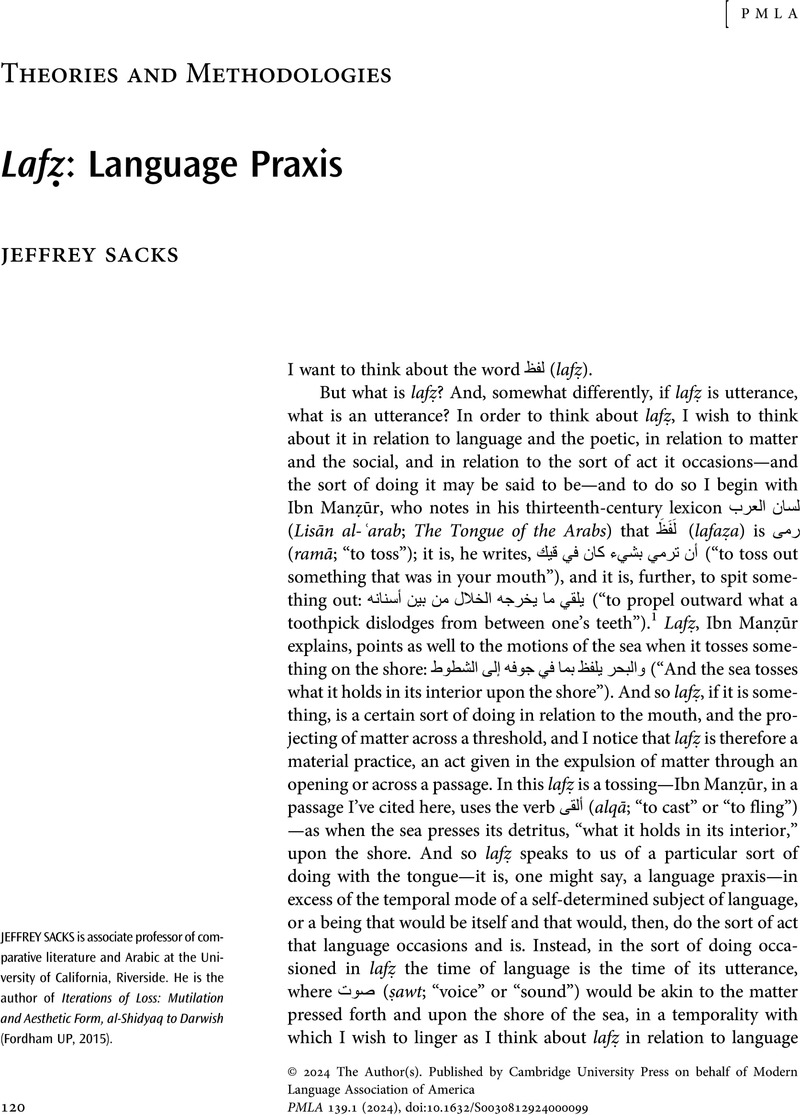No CrossRef data available.
Article contents
Abstract
An abstract is not available for this content so a preview has been provided. Please use the Get access link above for information on how to access this content.

- Type
- Theories and Methodologies
- Information
- Copyright
- Copyright © 2024 The Author(s). Published by Cambridge University Press on behalf of Modern Language Association of America
References
Works Cited
Allan, Michael. In the Shadow of World Literature: Sites of Reading in Colonial Egypt. Princeton UP, 2016.Google Scholar
ʿAskarī, Abū Hilāl al-. كتاب الصناعتين الكتابة والشعر [Kitāb al-ṣināʿatayn al-kitābah wa al-shiʿr]. Edited by Qumīḥa, Mufid, Dar al-Kutub al-ʿIlmiyyah, 1984.Google Scholar
Hamacher, Werner. Minima Philologica. Translated by Diehl, Catherine and Groves, Jason, Fordham UP, 2015.Google Scholar
Harb, Lara. Arabic Poetics: Aesthetic Experience in Classical Arabic Literature. Cambridge UP, 2020.CrossRefGoogle Scholar
Qutayba, Ibn. أدب الكاتب [Adab al-kātib]. Edited by Juwaydī, Darwīsh, al-Maktaba al-ʿAsriyya, 2019.Google Scholar
Rashīq, Ibn. العمدة في محاسن الشعر وآدآبه ونقده [al-ʿUmdah fī maḥāsin al-shiʿr wa-ādābihi wa-naqdihi]. Dar al-Jīl, 1981.Google Scholar
Iṣfahānī, al-Rāghib al. محاضرات الأدباء ومحاورات الشعراء والبلاغاء [Muḥāḍarāt al-udabāʾ wa-muḥāwarāt al-shuʿarāʾ wa-l-bulaghāʾ]. Edited by Zaydān, Ibrahīm, Maṭbaʿat al-Hilāl, 1902.Google Scholar
Jāḥiẓ, al-. البيان والتبين [al-Bayān wa-l-tabyīn]. Edited by Juwaydī, Darwīsh, al-Maktaba al-ʿAsriyya, 2003.Google Scholar
Jāḥiẓ, al-. كتاب الحيوان [Kitāb al-ḥayawān]. Edited by Muḥammad Hārūn, ʿAbd al-Salām, al-Maktabah al-ʿAṣriyyah, 2015.Google Scholar
Jurjānī, al-Sharīf al-. كتاب التعريفات [Kitāb al-taʿrīfāt]. Edited by ʿAbd al-Raḥmān al-Marʿashlī, Muḥammad, Dār al-Nafāʾis, 2018.Google Scholar
Key, Alexander. Language between God and the Poets: Maʿnā in the Eleventh Century. U of California P, 2018.Google Scholar
Miller, Jeannie. “Man Is Not the Only Speaking Animal: Thresholds and Idiom in al-Jāḥiẓ.” Arabic Humanities, Islamic Thought: Essays in Honor of Everett K. Rowson, edited by Lowry, Joseph E. and Toorawa, Shawkat M., Brill, 2017, pp. 94–121.CrossRefGoogle Scholar
Rastegar, Kamran. Literary Modernity between the Middle East and Europe. Routledge, 2007.CrossRefGoogle Scholar
Tageldin, Shaden M. Disarming Words: Empire and the Seductions of Translation in Egypt. U of California P, 2011.Google Scholar


